ARUBA - Ricardo, the man taking me on a driving tour of this lovely Caribbean nation whose motto is “One Happy Island”, is not happy.
“My wife forgot to put my sunglasses back in the car and now I will be squinting all day,” he moans after picking me up at the exclusive Tierra del Sol Resort; home to the island’s only 18-hole golf course, a Robert Trent Jones Sr. beauty that hugs the Caribbean Sea coast.
Maybe the sun won’t come out today, I suggest. Ricardo frowns.
“My friend, the sun always shines on our island — we get less than 20 inches (50 centimetres) of rain annually, so that means lots of sunny days.”
Ricardo says our tour will be short. “Our island is very small (less than 33 kilometres long and about 10 kilometres wide at its widest point). We’ll have plenty of time to see all the highlights and I’ll still get you to the dock for that catamaran sail I promised you later today.”
With that, Ricardo turns his car onto the main highway which completely encircles this coral island of snow-white beaches, tall cactus and honeycomb rock formations.
The road is lined with candy-coloured homes and Ricardo points to handsome Santa Anna Church where workmen are hurriedly repairing part of its roof, which was torn off when a small tornado touched down the night before.
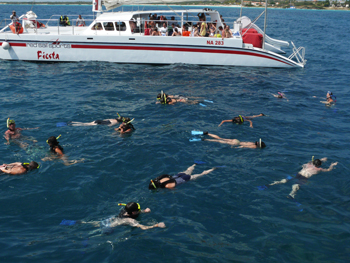
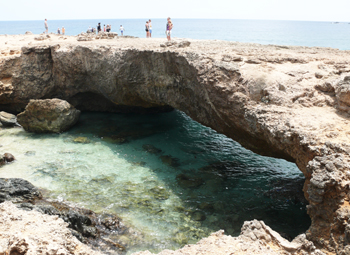
Left: Snorkelling is the national sport. Right: Special place, special landscape.
Because Aruba sits about 25 kilometres off the Venezuelan coast, there’s a distinct Spanish influence in the island’s architecture.
We are heading in the direction of an iconic lighthouse at the northernmost tip of the island which has become Aruba’s most famous landmark. The 30-metre-high California Lighthouse (named for the steamship California which wrecked on the jagged rocks just offshore in 1891), overlooks the island’s treasured sand dunes and secluded Arashi Beach, which boasts the whitest sand on the island.
The parking lot is filled with buses carrying Latin American tourists, all of whom want their photographs taken in front of the lighthouse.
“Most of our tourists come from the United States and Canada, but in recent years, thanks to the economic boom in places like Venezuela, Colombia, Panama and especially Brazil, we are seeing a lot more of our Latin American neighbours,” says Ricardo, who adds, “Aruba boasts an impressive 30 per cent repeat visitor ratio — the highest in the Caribbean.”
Back on the highway, Ricardo points the car in the direction of Oranjestad, the charming capital whose Dutch name reminds us of the influence Holland had on this small nation when it was part of the Dutch West Indies.
Aruba got its independence in 1986 but Dutch influence remains — while the island has its own parliament, Aruba’s foreign affairs interests are still handled by the Dutch government and Queen Beatrix remains the island’s head of state. The capital is being spruced up on this late August day for the monarch’s visit a few weeks later.
Just before entering the charming capital, we pass bustling beach areas lined with high-rise hotels, casinos and clubs.Palm Beach and Eagle Beach are where most of the tourists gather and where cruise ship passengers come to party while in port. Aruba is one of the most popular cruise destinations in the Caribbean and each year welcomes 320 ships and over 600,000 passengers.
Over an early lunch of freshly caught fish at a quaint local restaurant in Oranjestad, I hear people talking a lilting, melodic language.
“That’s our local tongue — Papiamento,” says Ricardo. “It’s a combination of many languages, including Spanish, Dutch, Portuguese and English.”
While we eat, he talks about the 96 different nationalities that live on this tiny spit of land in the Caribbean Sea and about how Aruba has the best drinking water in the world.
“That’s scientific fact, not me boasting,” smiles Ricardo.
The drinking water here is fresh from the tap — no need for bottled water — and its purity comes from the fact that it’s filtered by the island’s sand and coral rock.
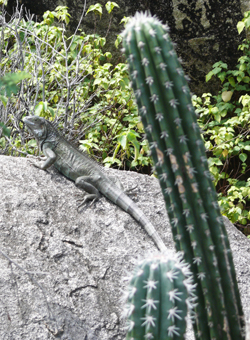
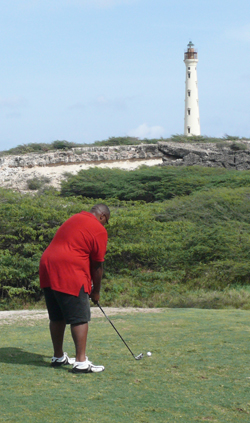
Left: This truly is a desert island. Right: Golf rules in Aruba.
Aruba is a diver’s paradise. Coral reefs and wrecks give masked visitors plenty to explore and Ricardo reminds me that our catamaran outing is at 3 p.m., so eat up because there’s still some things I want to show you before we go snorkeling.”
Ricardo cuts through the centre of the island on some dusty back roads where Aruba’s harsh desert landscape is fully exposed. Here, giant cacti and bulging rock formations dominate the horizon.
At Paradera, my driver stops at the entrance of the Casibari Rock Formations; giant boulders exposed when the sea pulled back millions of years ago.
Visitors climb the rocks where large iquanas lie sun tanning on blistering hot boulders. If you climb all the way to the top, Ricardo tells me, your IQ will increase by 20 per cent “because the rock surface makes people smarter.”
Another scientific fact, I wonder? “No, just a good local legend,” smiles Ricardo.
We see other giant rocks — the Ayo Rock Formation — just before we reach the coastal highway again and the driver turns north, where we come upon a colourful little church known as Alto Vista Chapel, built by settlers in 1750. The iconic little church has become a tourist stop but hymns being sung inside remind us that locals still come here every day to pray.
A short drive south from the church, we visit the Bushiribana Ruins, an old fort-like complex where early Dutch would bring the gold they extracted from the interior and melt it down before loading it on ships bound for Amsterdam.
In front of the ruins is a beach area known as the “Wish Garden” where hundreds of tiny inukshuks line the shore — an indication that Canadians have left their mark on this stretch of sand.
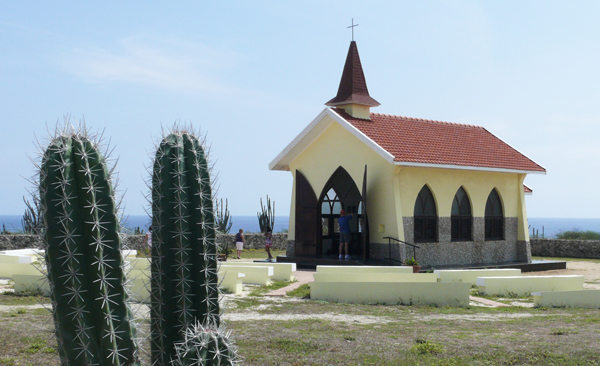
Above: Santa Anna Church.
The site of the natural bridge Ricardo has been so anxious to show us comes into view as we hit the top of a hill. But where’s the bridge?
“It collapsed — a victim of nature a few years ago,” sighs Ricardo.However, the number of buses in the parking lot indicates that the site, which offers a smaller natural bridge known as Baby Bridge, and a coastal view that’s simply breathtaking, remains a popular tourist stop.
On the drive back to Oranjestad to catch our catamaran, I can’t help noticing some wind-shaped trees that line the roadway.
Ricardo identifies them as diva-diva trees, which owe their shape to the constant trade winds that blow ashore here.
Catamaran tours are one of the most popular activities on Aruba. Visitors pile onto the sleek two-hull sailing vessels and venture just offshore where they snorkel and dive in waters teeming with reefs and wrecks.
Our catamaran captain goes over all the safety instructions before we push off to explore the Antilla, a World War II wreck which her German captain scuttled rather than hand it over to the Allies.
The water surrounding the wreck is teeming with tropical fish and the kaleidoscope show is well worth the $40 sailing fee — a three-hour tour that includes snacks and an open bar.
While enjoying an Aruban cocktail (lots of spicy rum and a splash of fruit juice) on deck after our dive, a smile breaks across Ricardo’s face as he rummages through his knapsack and pulls out his sunglasses.
“The glasses were here all the time,” he laughs. “I’m happy now.” It’s not hard to smile when you’re on this “One Happy Island” called Aruba.
Information
• Air Canada Vacations, Sunwing and Air Transat offer seasonal service to Aruba.
• Best times of year to visit Aruba are January to March – and especially during Carnival time just before Lent.
• One of the best places to visit in Aruba is Arikok National Park, home to great hiking and biking trails, natural rock formations and many caves.
• Aruba has become a preferred honeymoon destination in recent years.
• Food on Aruba is a blend of Caribbean and South American recipes.
• Our of out favourite restaurant on Aruba is Papiamento, housed in the old Ellis Family home which is still run by the family.
• For more information on Aruba, go to http://www.aruba.com.